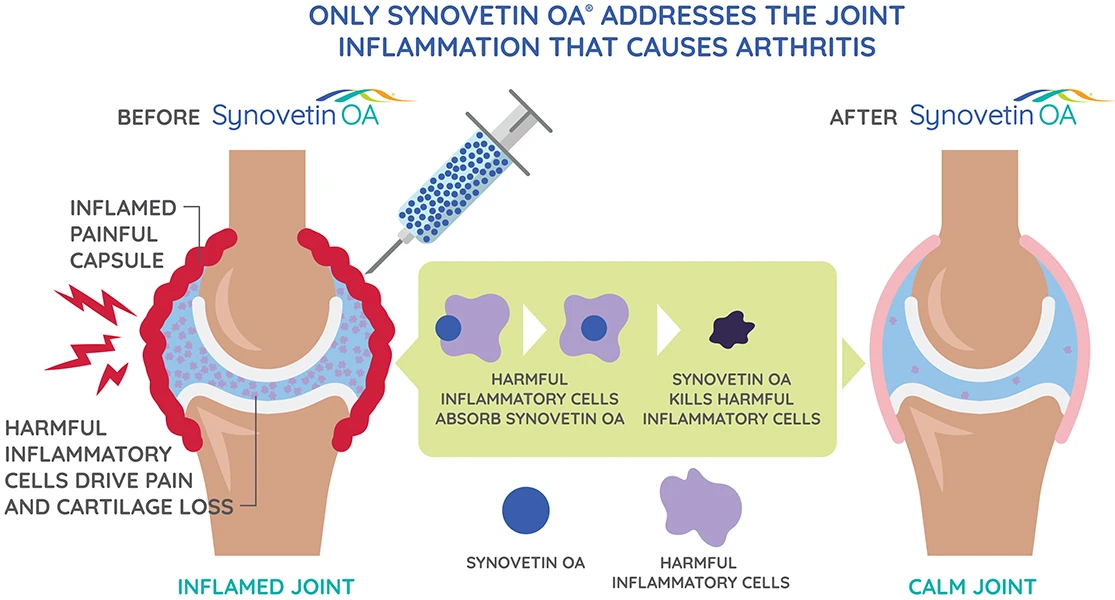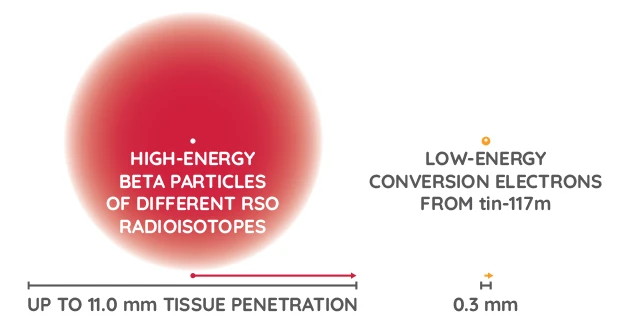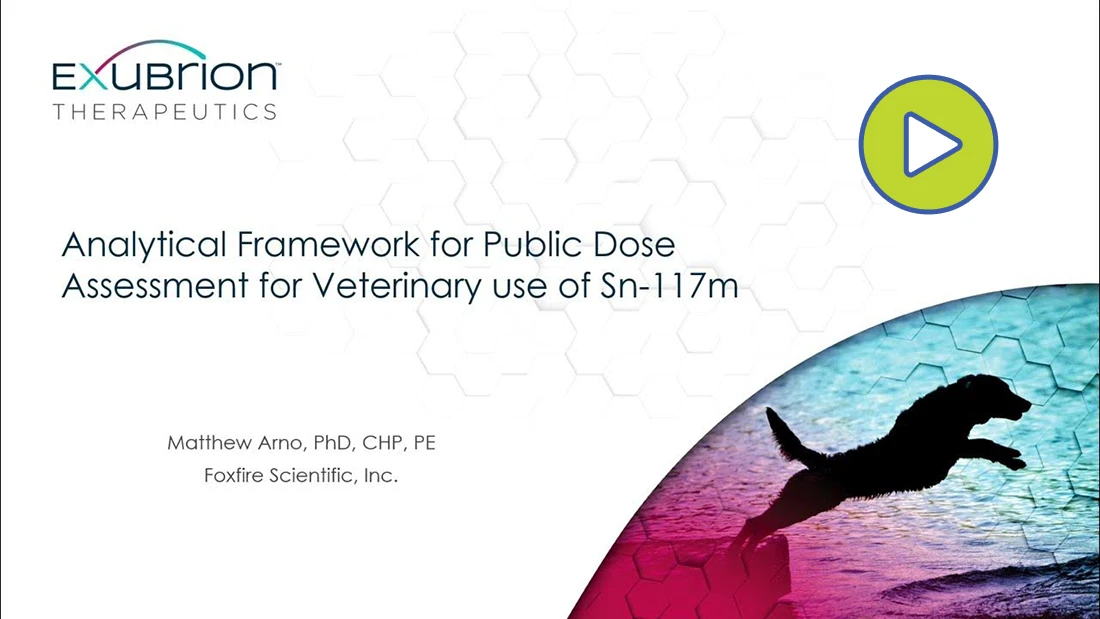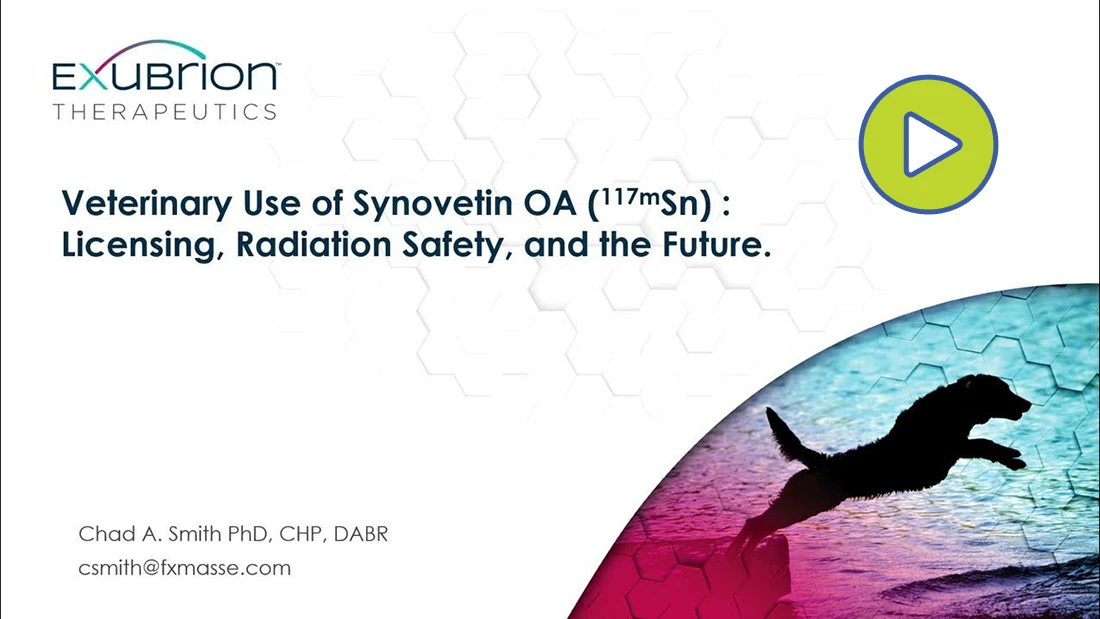
- Minimally invasive procedure known as radiosynoviorthesis, or RSO1-3
- Precisely delivers energy safely ablate activated synoviocytes and macrophages4
- Tin-117m has the potential to slow OA progression, as demonstrated in rodent models5-7
- No systemic distribution or effect on bone, cartilage, or other joint structures8

Forms of energy
- Monoenergetic conversion electrons (significant energies 127–158 keV; emission probability 113%)
- Imageable gamma radiation (159 keV, 86% abundant)
- Accompanying low-energy emissions are Auger electrons (<21 keV) and X-rays (<30 keV)
Unique advantages
- Distinct from high-energy beta particles that have a wide tissue penetration range (50–11,000+ μm)9

- Ultra-narrow, discrete radiation range enables more precise dosimetry and avoids adverse effects on adjacent tissues

Local/targeted treatment:
- Limited penetration—99.1% is retained in the joint space;
does not affect fur, feces, or urine - The treated dog can go home the same day with no need
for confinement
Leading experts in nuclear medicine share insights on Synovetin OA®
These brief webinars, presented by Exubrion Therapeutics, feature lectures on product characteristics, safety, licensing, and use.
Synovetin OA

Tin-117m and Synovetin OA in Veterinary Science
Nigel Stevenson, BSc, PhD, COO
Exubrion Therapeutics, Inc.
Dr. Stevenson has over 35 years of experience in isotope production and research. He is the co-founder and Chief Operating Officer of Exubrion Therapeutics. He has held senior positions in several radioisotope manufacturing and research companies in addition to academic roles at National Laboratories. He has over 90 publications and more than 30 patents in this field. He is the Immediate Past President of the World Council on Isotopes. He holds a BSc in physics and a PhD in nuclear physics from The University of London, U.K.
Lecture Topic:
Hear Dr. Stevenson cover the characteristics of the isotope tin-117m and how it is incorporated into a veterinary device (Synovetin OA) that is used to treat canine osteoarthritis.
- Provides an overview of the treatment modality using this product, called radiosynoviorthsis (RSO), which has been used in humans for over 60 years with different products and isotopes
- Explains RSO, compares the other human agents, and demonstrates why Synovetin OA is ideal for this veterinary application

Synovetin OA

Analytical Framework for Public Dose Assessment for Veterinary Use of Tin-117m
Matthew Arno, PhD, COO
Partner Foxfire Scientific
Dr. Arno has over 30 years of experience specializing in radiation safety and regulatory compliance associated with medical and industrial applications of radioactive material including veterinary uses and oil and gas and mining and milling.
Lecture Topic:
Watch Dr. Arno present information on how tin-117m as a therapeutic agent required ground-up development for ensuring the dose to the public stayed within regulatory limits.
- Discusses how tin-117m differs from other veterinary radioactive materials due to a relatively long half-life and lack of systemic uptake
- Provides information on the studies that were done to characterize:
– The radiation field around a treated animal
– The nature and distance of common interactions
– The dose absorbed by a person in proximity to a treated animal

Synovetin OA

Veterinary Use of Synovetin OA (117mSn): Licensing, Radiation
Safety, and the Future
Chad A. Smith, PhD, CHP, DABR
Partner FX Massé Associates Inc
Dr. Smith is a medical physicist for general radiography, fluoroscopy, ultrasound, computed tomography, magnetic resonance imaging, and FDA approved in mammography. He is a member of the American Association of Physicists in Medicine and the Health Physics Society and is certified by the American Board of Health Physics in the practice of Health Physics.
Lecture Topic:
Join Dr. Smith for a discussion on the licensing, use, and publications related to Synovetin OA, a novel radiotherapeutic used to treat canine osteoarthritis.
- Covers currently licensed locations and use data
- Reviews off label uses of canine joints and other species, clinical effectiveness and adverse events
- Explores what the future may hold for this product


